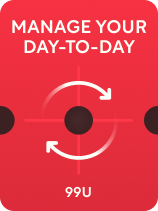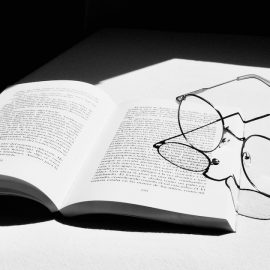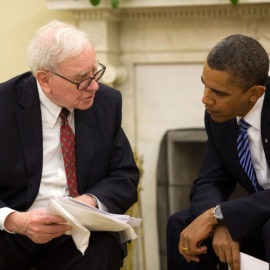

This article is an excerpt from the Shortform book guide to "Manage Your Day-to-Day" by 99U and Jocelyn K. Glei. Shortform has the world's best summaries and analyses of books you should be reading.
Like this article? Sign up for a free trial here.
Are you a creative professional or aspiring to be one? Do you need some help figuring out a work routine and staying focused and motivated?
Manage Your Day-to-Day is a collection of essays edited and curated by 99U’s Jocelyn K. Glei. The essays help creative professionals learn how to develop a routine that supports creativity, how to improve their focus, and how to hone their creative mindset.
Continue reading for an overview of this inspiring book that can take your creative work to the next level.
Overview of Manage Your Day-to-Day
Jocelyn K. Glei is a creative consultant and the director of 99U, a resource platform and conference series that empowers creative professionals. Compiling advice from creative professionals and creativity experts, Glei shows that consistent, disciplined work habits are the true foundation of creativity. The essays in Manage Your Day-to-Day offer strategies to optimize your productivity, focus, and creativity in today’s fast-paced world, as well as practical tools to enhance your daily routine, overcome distractions, and unlock your creative potential.
Glei is an American writer and creative consultant. In addition to managing 99U’s online content and the annual 99U Conference, an event that brings together visionaries and thought leaders from various creative fields, Glei also hosts the podcast Hurry Slowly and offers a four-week online productivity course called RESET. For Manage Your Day-to-Day, Glei curated essays from some of today’s best-known creative minds, including Cal Newport (Deep Work), Steven Pressfield (The War of Art), and Gretchen Rubin (The Happiness Project and The Four Tendencies).
We’ve divided the contributors’ wisdom into three areas: how to build a routine that fosters creativity, how to increase your focus, and how to sharpen your creative mindset.
How to Develop a Routine That Supports Creativity
Many of the contributors suggest that the first step to becoming more creative is prioritizing creative work. The best way to do this is to build a routine around your creative projects. Without an intentional routine, they argue, it’s unlikely you’ll ever make significant progress on your biggest and best ideas.
Step 1: Identify When You Are Primed for Creative Work
Poet and creativity coach Mark McGuinness suggests that your routine should center around your periods of highest focus. He explains that everyone has a circadian rhythm that determines your level of mental alertness throughout the day. He recommends aligning your routine with your energy level to ensure that you work on your creative projects at the times you’re most focused.
The author of Deep Work, Cal Newport, advises that after identifying your focus periods, you block them out in your calendar. Scheduling this time, as you would an important meeting, not only reminds you that time is saved for your creative work but also allows you to focus on those projects without interruption. He emphasizes that once you schedule your focus block, you shouldn’t allow anything to intrude, whether it’s phone calls, emails, or spontaneous interruptions.
Step 2: Be Consistent
Once you establish a routine, be consistent. According to Gretchen Rubin, author of The Happiness Project and The Four Tendencies, creativity thrives on consistency. She explains that consistency works because it’s realistic, allowing you to work on your creative projects a little bit every day while also managing your other personal and professional responsibilities.
Rubin adds that consistency isn’t only realistic, but it also fuels creativity. Working on a project a little bit every day keeps ideas fresh in your mind and makes it easier to start work every time. It also alleviates pressure and anxiety by ensuring steady progress and fosters a more playful mindset, increasing the likelihood of inspiration striking regularly. The beauty of consistency is that it’s self-reinforcing because consistently working on a project strengthens your belief in your ability to make progress on your creative work, instilling a sense of accomplishment and fueling your motivation to keep going.
Step 3: Make Time for Rest and Rejuvenation
As you develop a consistent routine, many contributors emphasize the importance of incorporating periods of rest. This means not only having boundaries to your work day to avoid burnout and ensure adequate sleep but also incorporating smaller breaks throughout your day. Tony Schwartz, CEO of The Energy Project, suggests taking a break every 90 minutes of work to ensure peak productivity.
How to Improve Your Focus
It’s not enough to establish a routine for your creative work; you also need to focus on your creative projects when you’re working on them. While the reality of constant connectivity can make it difficult to focus, it’s still possible. Maintaining focus and avoiding distractions is a skill you can develop with practice. With improved focus, you’ll be able to engage more deeply in the creative process, increase your productivity, and more effectively generate new ideas.
Step 1: Be Intentional
Often the decisions you make that cause you to lose focus—to check email, answer a text message, or grab yet another cup of coffee—are unconscious choices. According to behavioral economist Dan Ariely (Predictably Irrational), most of the choices we make are unconsciously determined by what he refers to as choice architecture, the arrangement of options that influence our decision-making.
Ariely explains that, by organizing your environment to minimize distractions and setting defaults that encourage focus, you can create environments that help you concentrate better and avoid choices that hinder your ability to pay attention. For example, if you often find yourself getting distracted by social media, you can change the choices available by turning off your phone. This change in the choice architecture will reduce the temptation to check your phone and keep your attention focused on your creative work.
In addition to setting up your environment to encourage focus, practice focusing for longer periods of time. Newport suggests identifying a concrete task and then focusing on that task for one hour. If you’re able to sustain focus that whole time, without succumbing to any distractions, then add 15 minutes to your focus time every two weeks. If you get distracted, he suggests stopping and trying again later. This will train your mind that distractions are unacceptable.
Another way to practice focus is through meditation. According to Leo Babauta, author of The Power of Less, being still and focusing on your breath will improve your ability to sustain attention. This practice also cultivates heightened self-awareness, allowing you to recognize distracting thoughts and resist the pull of distractions, enabling you to stay present in the moment.
Step 2: Manage Distractions
For many of us, technology is the number one source of distraction. James Victore, designer, filmmaker, and the author of Feck Perfuction, explains that many of us have allowed our devices, with their constant alerts and buzzing, to determine our priorities. He insists that the key to developing a healthy relationship with technology is to remind yourself that you’re in control of how you focus your attention and to make sure you’re using technology in service of your priorities.
Social media and email are often the worst sources of distraction, easily pulling our attention away from more important work. Lori Deschene, founder of Tiny Buddha, says that it’s important to pay attention to when and why you engage with social media. Social media can be helpful as long as you make sure you’re using it intentionally in a way that serves you and your work.
Aaron Dignan, the founder of The Ready and author of Brave New Work, has a similar suggestion for how to manage email. He suggests considering every email through the lens of your long-term goals by following two simple rules:
First, keep your long-term goals in mind. Email often pertains to how we manage the minutiae of our day, but, according to Dignan, most of those smaller tasks connect to larger goals. If you’re clear on your long-term goals, you can mentally organize your email according to how the correspondence impacts those goals.
Second, give yourself permission to say no. You’ll inevitably get emails that don’t have any connection to your goals or priorities. Don’t let distracting opportunities pull you away from what’s most important. You can’t do everything, so don’t try. If you get an opportunity or request that will distract you from your goals, say no, and move on.
Step 3: Stop Multitasking
One of the ways we lose our focus is by trying to do too many things at once. Christian Jarrett, psychologist and editor of Psyche magazine, argues that if you want to improve your focus, you should stop trying to multitask. He explains that the ability to multitask is a myth. People who claim to multitask are in fact task-switching, shifting attention quickly from one task to another, which gives neither task full focus. Task-switching over the course of a day or several hours can also negatively impact your focus because it requires constant mental readjustment and can lead to decreased productivity and increased cognitive fatigue.
Jarrett explains that starting a new task before the first is finished can leave what scientists call “attentional residue” where your brain is still at least partially occupied by the unfinished task. He suggests that if you have to leave a concrete task unfinished, try to pause at a logical stopping point that leaves at least one portion of the task complete.
How to Hone Your Creative Mindset
As you give yourself more time to work on creative projects, you also need to practice honing a creative mindset that keeps you inspired and helps you better work through challenges and creative blocks.
Step 1: Prioritize Unstructured Creativity
Todd Henry, the founder of Accidental Creative, suggests that the key to sustaining creativity is to make time for unstructured creativity (what he calls “unnecessary creation”)—creative projects or activities that may not have a specific practical purpose or immediate outcome. He explains that while it may seem counterintuitive to invest valuable time in something seemingly purposeless, doing so will nourish your creativity and keep your motivation alive.
Henry writes that, when creative people only apply their skills within the confines of their job, they can become frustrated by the restrictions and judgment attached to their work and eventually lose inspiration. Unstructured creativity, on the other hand, allows you to break free from constraints and external demands and tap your true creative potential. It fuels inspiration by making room for the exploration of new ideas and the development of new skills and perspectives, reconnecting you with your intrinsic drive to create.
To prioritize personal creative projects, Henry suggests dedicating regular blocks of time for unstructured creativity. He also suggests maintaining a list of exciting projects to work on during that time and keeping a notebook to capture intriguing questions and ideas. That way you’ll always have an idea you can be working on.
Step 2: Reject Perfectionism
Even when working on purely personal projects, many creative people still struggle with perfectionism, but, according to Elizabeth Grace Saunders, the author of The 3 Secrets to Effective Time Investment, perfectionism is the enemy of creativity.
She explains that there are typically two contrasting approaches to creativity: striving for flawless execution or valuing practicality over perfection.
Those who strive for flawless execution refine every detail and seek the elusive ideal of perfection. They can be highly critical of their own work and may be hesitant to share it until it meets their lofty standards. Perfectionism not only prevents them from taking risks but often prevents the work from ever being completed or shared.
On the other hand, those who value practicality and progress prioritize taking action, embracing imperfections, and iterating on their ideas. Rather than being hindered by the fear of failure or the pursuit of an unattainable ideal, they focus on experimentation, learning, and adapting their work along the way. They understand that imperfections and mistakes are integral to the creative process and use them as stepping stones to refine and improve their creations.
Acknowledging that we all want to do our best work, strive to value practicality and progress. You’ll produce more creative work and be less stressed in the process.
Step 3: Lean Into Challenges
Whether a perfectionist or a pragmatist, you’ll inevitably feel stuck sometimes. Creativity coach Mark McGuinness explains that, while these moments can feel paralyzing, they have the potential to inspire rather than frustrate.
He argues that understanding the type of creative block you’re facing can be a powerful tool in overcoming it. Here are several common types of creative blocks and suggested strategies to move through them:
Lack of inspiration: If you find yourself lacking inspiration for a project, take a break and allow your unconscious brain to continue working on it in the background, even if your conscious mind isn’t actively engaged.
Lack of extrinsic motivation: The pressure for success can be overwhelming and hinder creativity. Create a dedicated space or time solely for creative pursuits, free from discussions about business or money, to protect and nurture your creative process.
Emotional block: Sometimes, an emotionally intense or intimidating project can lead to procrastination. Remind yourself that you have the ability to create whatever you desire, and ultimately you have control over who will eventually see your work.
Personal issues: While challenges in your life can block creativity, the reverse can also be true: Your creative projects can serve as an oasis from life challenges. Embrace the opportunity to gain fresh perspectives by temporarily stepping away from the issues you’re wrestling with.
Limited resources: Whether it’s a lack of financial resources, time, or knowledge, you can make a virtue of necessity by setting yourself the creative challenge of achieving as much as possible with what you have. Remind yourself that more resources don’t always lead to better results.
Step 4: Take Opportunities to Unplug
Finally, to hone your creative mindset, take breaks from technology. According to Tiffany Shlain, filmmaker and the author of 24/6, disconnecting from screens allows you time to focus on your relationships, personal reflection, and creativity. She advocates for a “technology shabbat,” a practice of turning off all screens for one day a week. As Scott Belsky, Adobe’s chief product officer and co-founder of Behance, explains, disconnecting from the constant flow of information and communication will empower you to tap your imagination, be more in touch with your instincts, and take advantage of unexpected opportunities and connections that you might’ve otherwise missed.

———End of Preview———
Like what you just read? Read the rest of the world's best book summary and analysis of 99U and Jocelyn K. Glei's "Manage Your Day-to-Day" at Shortform.
Here's what you'll find in our full Manage Your Day-to-Day summary:
- That creativity is the result of disciplined work habits, not innate genius
- Tips from experts on how to boost your creativity, focus, and productivity
- Why you should never strive for creative perfection






